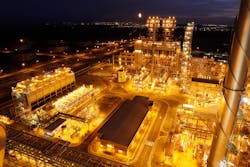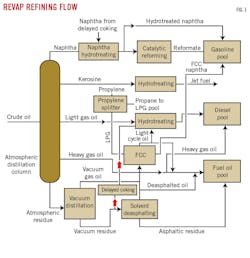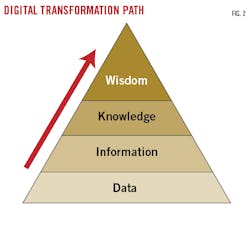Carina Pederiva Laidens
Petróleo Brasileiro SA
São José dos Campos, São Paulo, Brazil
Marcio Wagner da Silva
Petróleo Brasileiro SA
São José dos Campos, São Paulo, Brazil
Application of the adage that “data are the new oil” to the transformation of the crude oil industry has become increasingly frequent in recent years, primarily as it relates to evolution of technology that aids quick and easy access to vast amounts of data. Compilation of these data and their subsequent conversion into integrated, usable information aimed at ensuring agile and efficient decision-making has become the focus of the so-called digital transformation at the center of Industry 4.0, which involves developing and incentivizing of interactions between multiple teams. This transformation is driven by two main forces—a first that focuses on maintaining reliability and profitability of current operations to sustain development of future operations, and a second that concentrates on desired future operations—both of which encourage incremental improvements and disruptive innovation.
This article discusses Petróleo Brasileiro SA’s (Petrobras) implementation of a digital transformation program designed to capture and maximize use of existing operational data to help improve future operations and processes at its 252,000-b/d Refinaria Henrique Lage (REVAP) refinery in São José dos Campos, São Paulo, Brazil. While still in its initial stages, the program is helping create a more agile and dynamic decision-making process that, alongside ensuring safer, more reliable, and profitable operations, also enhances refinery processes and improved compliance with production planning.
Refinery overview
As Brazil’s third largest refinery, REVAP focuses on producing transportation fuels mainly for supply to the country’s domestic market. The refinery’s main production slate includes diesel (28%), gasoline (22%), jet fuel (14%), and fuel oil (13)% for distribution to Paraíba Valley, the northern coast of São Paulo, southern Minas Gerais, the São Paulo metro region, midwestern Brazil, and southern Rio de Janeiro. The refinery also supplies 100% of jet fuel to São Paulo and Guarulhos international airports (OGJ, May 4, 2020, p. 38).
Fig. 1 shows a simplified diagram of REVAP’s processing scheme.
Digital transformation program
In 2018, Petrobras implemented a digital transformation program at REVAP that intended to integrate the refinery’s current management and processing data into a single, unique database designed to convert these data into practical information and knowledge that, in turn, could guide future operational decision-making at the site.
Fig. 2 shows the evolutionary path of digital transformation—as represented by the data, information, knowledge, and wisdom (dikw) pyramid—on which REVAP based its program.
The major challenge in undertaking any digital transformation process occurs precisely in the first step of converting and distilling readily available data into useful information that will support creation of a decision-making system. As REVAP understood before implementing the project, it is a misconception to think of digital transformation as a purely technological event.
While technology allows easy and quick access to large quantities of data, true digital transformation involves changing mindsets of technology and management staff in terms of how they approach integrating, critically analyzing, and finally converting these data into actions that improve the decision-making process. This is particularly true of technology and management teams in the refining industry, where transforming mindsets that have for generations been conditioned to maintain staunch points of view and strict interpretations—developed typically in isolation—into those open enough to collaboratively work on integrated and effective data analyses no doubt will require transparency, clarity, and high-quality data availability as part of the shared data-analyzing program.
A great advantage of REVAP’s project implementation was its approach in presenting data in a simple way that allowed for both agility of acquisition and space for staff to insert critical analyses. These analyses were in turn were treated as additional integrated data. Moreover, once the refinery had established a database sufficient to promote the desired transformation, REVAP did not require any new data acquisition or monitoring systems, eliminating the need to purchase additional software or licenses and reducing the program’s overall implementation cost.
Another hallmark—as well as a founding premise—of REVAP’s digital implementation program was its ability to integrate data from the original database, which kept changes in a user’s normal routine to a minimum. Presented in an integrated and easily readable way and accompanied by analyses carried out by the technology staff, data are transformed into information that lends clarity to the management staff’s decision-making process but still always respects the core principles of maintaining integrity of current operations, minimizing losses, and developing bases for the refinery’s strategic plan.
REVAP’s initial goal during project implementation was integrating all opportunities for profitable gain already mapped in the operational process into a single visualization tool that could be used to ensure more assertive decision making in prioritizing studies, operational activities, or maintenance.
Fig. 3 shows an example of the form in which REVAP presented aggregated data for use as a digital visualization tool.
As a result of its data-integration process and visualization tools, evaluations previously executed by individuals in isolation now could be carried out in a collaborative manner, allowing integration of different teams’ points of view. This enabled REVAP to avoid distortions in analyses of strategic matters related to plant reliability and business profitability, as teams now could focus collectively on actions that ensured postive outcomes for both.
At REVAP, major advances in the quality of available data also supported increased information flow between management areas, resulting in creation of reliable decision-making schema that promoted more agile and assertive decisions. The operator’s use of JIRA commercial software allowed technology and management staffs to carry out and register analyses that exposed main threats to the refinery’s ability to accomplish some actions. These analyses, in turn, have been treated as further data that can be used to ensure enhanced agility and assertiveness in the decision-making process.
Fig. 4 shows the management flow scheme REVAP adopted following implementation of the digital transformation project.
One of the key requirements in achieving desired outcomes for refinery operations is an adequate asset-management system. Due to REVAP’s limited maintenance resources, one of the main deliverables of the digital transformation project was prioritization of outstanding maintenance orders that specifically focus on increasing security and profitability of individual processing units. The combination of monitoring real-time process data with REVAP’s maintenance-prioritization system following the project’s implementation has allowed the refinery to more quickly identify inefficiency points and apply solutions.
Despite its vast aggregation of available data from the refinery’s current operations, REVAP produced no new data during the digital transformation. The operator instead maximized use of its integration process, adopting actions aimed at both heightening integration and critical analysis of existing data to increase the quality of information available to inform better decisions.
Next steps
The main objective of asset management in the scope of Industry 4.0 is to implement prescriptive maintenance based on a system of prescriptive analytics (Fig. 5).
The concept of prescriptive maintenance involves analyses of process and equipment operational details in order to anticipate potential failure as well as minimize production losses based on discovery of possible profit losses or unit inefficiencies. A future step in REVAP’s ongoing digital transformation program will include implementation of prescriptive maintenance technology.
Bibliography
Bonfietti, A., “Predictive and Prescriptive Maintenance,” Renewable Energy Mediterranean Conference & Exhibit, Ravenna, Italy, Mar. 14-15, 2018.
Campbell, J.D., Jardine, A.K.S., and McGlynn, J., Fundamentals of Petroleum Refining, 2nd ed., CRC Press, Boca Raton, Fla., 2011.
Cann, G. and Goydan, R., Bits, Bytes and Barrels—The Digital Transformation of Oil and Gas, 1st ed., MADCann Press, 2019.
Wilson, L., Lean Refining—How to Improve Performance in the Oil Industry, 1st ed., Industrial Press, South Norwalk, Conn., 2017.
Authors
Carina Pederiva Laidens ([email protected]) is a process engineer and production manager at Petróleo Brasileiro SA’s Refinaria Henrique Lage (REVAP) refinery in São José dos Campos, São Paulo, Brazil, with over 10 years’ experience as a downstream processing engineer focusing in process feasibility and optimization studies, process safety improvements, and more recently, industrial automation and IoT. She holds a BS (2004) in chemical engineering from Universidade Federal do Rio Grande do Sul, Porto Alegre, and an MBA (2020) in digital transformation from Pontifícia Universidade Católica do Rio Grande do Sul, Porto Alegre.
Marcio Wagner da Silva ([email protected]) is a process engineer and project manager at Petróleo Brasileiro SA’s Refinaria Henrique Lage (REVAP) refinery in São José dos Campos, São Paulo, Brazil. With a focus on crude oil refining, da Silva has extensive experience in research, design, and construction, as well as developing and coordinating projects for operational improvements and debottlenecking bottom-of-the-barrel units. He holds a BS (2004) in chemical engineering from Universidade Estadual de Maringá, Paraná, an MBA (2006) in project management from Universidade Federal do Rio de Janeiro, and a PhD (2010) in chemical engineering from Universidade Estadual de Campinas, São Paulo. He is certified in business and finance by Fundação Getulio Vargas.





